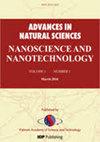Bio-engineered, phyto-decorated, multi-form P. betle/ZnO as a potential photocatalytic agent
IF 2.1
Q3 MATERIALS SCIENCE, MULTIDISCIPLINARY
Advances in Natural Sciences: Nanoscience and Nanotechnology
Pub Date : 2023-09-01
DOI:10.1088/2043-6262/acf28a
引用次数: 0
Abstract
The rising levels of water contamination worldwide signal a significant need for new materials for its restoration in the coming years. This study provides a novel, simple, cost-effective, and environmentally friendly approach for the production of zinc oxide (ZnO) nanoparticles (NPs) as a promising photocatalyst through the reduction of zinc nitrate hexahydrate using a leaf extract of Piper betle (P. betle). The wurtzite hexagonal structure of ZnO, with a crystallite diameter of 43.44 nm and an energy band gap of 2.97 eV, was seen in P. betle/ZnO. The Fourier transform infrared (FTIR) study showed that phytochemicals from the P. betle extract were present on the surface of P. betle/ZnO. The high-resolution transmission electron microscopy (HRTEM) and field emission scanning electron microscopy (FESEM) analyses revealed the existence of multiple structures scattered evenly (spherical, hexagonal, and rod-shaped). The BET findings indicate that P. betle/ZnO NPs have a highly porous structure with a significant surface area of 97.11 m2/g. The degradation of commercial dye was employed to evaluate the photocatalytic capability of P. betle/ZnO. With ultraviolet radiation, the removal percentage of light green dye might surpass 99% in 80 min with a degradation rate of 2.58 × 10−2 min−1. It was observed that the degradation kinetics follow pseudo-first-order kinetics. P. betle/ZnO is acknowledged as an effective photocatalyst for the treatment of commercial effluent.生物工程、植物修饰、多种形式的贝类/氧化锌作为潜在的光催化剂
世界范围内不断上升的水污染水平表明,未来几年对新材料的修复有很大的需求。本研究提供了一种新颖、简单、经济、环保的方法来生产氧化锌纳米颗粒(NPs)作为一种有前途的光催化剂,该方法通过使用Piper betle (P. betle)叶提取物还原六水硝酸锌。P. betle/ZnO为纤锌矿六方结构,晶体直径为43.44 nm,能带隙为2.97 eV。傅里叶变换红外(FTIR)研究表明,天牛提取物的植物化学物质存在于天牛/ZnO表面。高分辨率透射电子显微镜(HRTEM)和场发射扫描电子显微镜(FESEM)分析显示,存在均匀分布的多个结构(球形、六边形和棒状)。BET结果表明,贝草/ZnO NPs具有高度多孔结构,比表面积为97.11 m2/g。通过对工业染料的降解,考察了紫花苜蓿/ZnO的光催化性能。在紫外线照射下,80 min对浅绿色染料的去除率可达99%以上,降解率为2.58 × 10−2 min−1。观察到降解动力学符合准一级动力学。紫花草/氧化锌被认为是处理工业废水的有效光催化剂。
本文章由计算机程序翻译,如有差异,请以英文原文为准。
求助全文
约1分钟内获得全文
求助全文
来源期刊

Advances in Natural Sciences: Nanoscience and Nanotechnology
NANOSCIENCE & NANOTECHNOLOGYMATERIALS SCIE-MATERIALS SCIENCE, MULTIDISCIPLINARY
自引率
4.80%
发文量
0
 求助内容:
求助内容: 应助结果提醒方式:
应助结果提醒方式:


